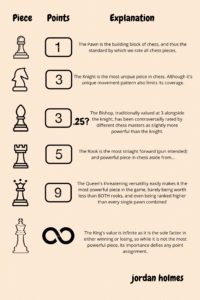If you’ve listened to my “check check check ins” you’ve heard me say things like “shoot I’m 2 points down,” or make evaluations such as “oh nice I can trade my bishop for their rook!” These thoughts are based in each piece’s respective point rating (click the picture below), and how those point rating’s statistically impact your chance of winning based on programs such as Stockfish. For a more detailed breakdown of these point values and examples of in-game moments where knowing them is beneficial, check out this article on chess.com. Stockfish also evaluates each individual piece’s static position in relation to each other piece on the board each turn, so as you can guess the algorithm is pretty intricate.
As a small side-note, in my last EdTech blog I talked about the benefits of open-source software’s focus on innovation over profit, and Stockfish’s mandate pushes that envelope to the extreme. The program is not only free to download, but also free to distribute and even SELL on its own or packaged in any software you create or bundle. The only caveat is that you must include, or cite, the source code.
To properly show exactly what this means, for this week’s check check check in I won’t be commentating my game in real time, but instead recording a reflection on the engines analysis of my game. Showing off both the statistical analysis of the engine, and the depth of it’s suggestions and utility for players to improve their gameplay.

Leave a Reply
You must be logged in to post a comment.